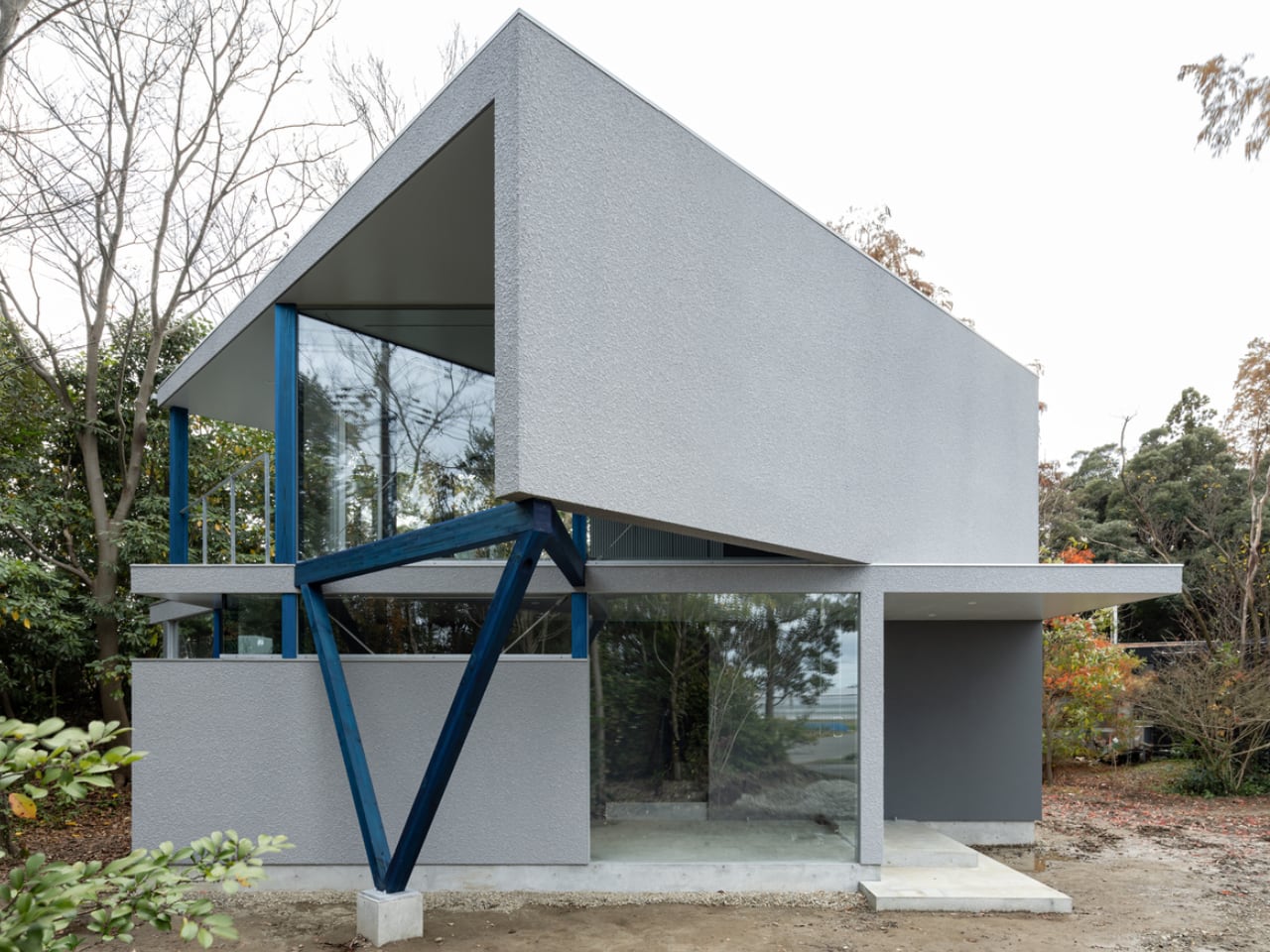Imagine stepping through the entrance of Studio Takuya Hosokai’s forest cakeshop and feeling your sense of orientation immediately slip away. The floor seems level, yet something feels profoundly off-kilter. Your eyes search for right angles but find none. A barista slides a perfectly square cake box across a counter while shadows fall at impossible angles across its surface. Welcome to 45°, where nothing aligns with expectations, and that’s precisely the point.
Located in Niigata’s ancient woodland, this architectural anomaly challenges conventional notions of spatial design through a deceptively simple concept: spaces rotated at precisely 45-degree angles throughout the structure, creating four distinct axes that deliberately disorient visitors and transform a modest cakeshop into an immersive journey through calculated spatial ambiguity.
Designer: The designer and architect of the 45° cakeshop and café in Niigata is Studio Takuya Hosokai, with Takuya Hosokai as the lead architect. The project was designed by Studio Takuya Hosokai and completed in 2023.
“We wanted people to experience the forest differently,” explains Hosokai in a rare interview about the project. “When you lose your bearings, you begin to see what was always there but never noticed.”
Bold Blues and Floating Planes
The exterior photographs reveal a structure that appears to levitate among the trees. Clean geometric forms assert themselves against organic irregularity, while bold blue steel supports arranged in striking V-formations slash through space with purpose. Their diagonal orientation aligns with the building’s conceptual framework while creating visual tension. These supports celebrate their structural purpose rather than hiding behind decorative facades.
Substantial concrete volumes anchor the building with reassuring weight, while extensive glazing counteracts this solidity, dissolving boundaries between inside and forest. The glass doesn’t simply frame views but virtually eliminates barriers, allowing the forest to become an extension of the interior experience.
In Niigata, snow loads reach depths of one meter, a standard structural requirement for buildings in the region. Traditional Japanese wooden construction techniques adapt throughout the structure to withstand these conditions. The cantilevered entrance canopy showcases remarkable engineering through flat beams providing stability against harsh weather. During winter, snow accumulates along these precise edges, creating visually striking formations that transform the building’s appearance, a phenomenon embraced throughout Niigata, where snow is celebrated as both a challenge and an artistic medium.
Material Conversations and Spatial Flow
Every junction where materials meet tells a story. Concrete greets steel with precise detailing. Glass meets wood with intentional clarity. Each connection emphasizes independence while maintaining harmony, creating a visual rhythm that extends throughout the structure.
The site plan reveals thoughtful positioning within 4,500 square meters of ancient forest. The building maintains respectful dialogue with an existing restaurant completed earlier on the same property, with trees surrounding both structures, their natural placement preserved. A visitor from Tokyo remarked, “I came for cake but found myself studying trees for an hour. Something about the angles made me notice their shapes differently.”
Inside, overlapping volumes create unexpected relationships that continuously reframe the forest beyond. White surfaces serve as canvases for the ever-changing natural light, while circular openings punctuate the ceiling, introducing focused beams that track across floors throughout the day. Textured vertical panels introduce tactile richness without competing with the angular geometry dominating the design. Floor surfaces remain minimal and continuous, allowing effortless movement through rotated volumes without encountering thresholds.
Perceptual Puzzles and Temporal Shifts
The rotated axes create visual disruptions that demand active engagement. You cannot passively occupy this space. It activates senses and requires participation in the experience. A staff member mentions that regular customers request specific tables based on the season. Some prefer morning light through autumn leaves, others the way afternoon sun creates patterns through bare winter branches.
“After ten minutes inside, the forest outside looked different to me,” notes a regular patron. “The trees seemed more intentional somehow, as if I was seeing their geometry for the first time.”
The building transforms with changing light and seasons. Morning reveals crisp edges and definitive shadows. Twilight softens everything, creating a luminous object floating among trees. Autumn brings warm colors that contrast with the cool blue supports. Winter snow creates new geometries atop the existing forms. A local farmer passing by each evening calls it “our geometric moon.”
Raw concrete textures contrast with glass transparency and steel precision. Each material speaks honestly without pretense. On rainy days, the concrete darkens while the blue supports remain vibrant, creating new relationships between elements that seemed fixed. The architecture becomes a dynamic canvas for natural phenomena, responding to and amplifying subtle changes in its forest environment.
Human Experience Beyond Function
A young couple visits weekly, not just for the excellent cakes but for what they call “the tilted perspective.” They’ve developed a game of trying to photograph their desserts so they appear level while the forest beyond reveals the true orientation. Architecture becomes a playground for perception, a device for seeing differently.
The cakeshop transforms how visitors experience the forest through unexpected perspectives. Its 45-degree rotation disrupts habitual patterns, forcing fresh engagement with familiar elements. An elderly local resident commented, “I’ve lived beside these woods for seventy years, but never saw them quite this way before.”
Approaching the building, you experience gradual revelation rather than immediate understanding. The path curves slightly, offering glimpses that build anticipation. This choreographed approach reinforces discovery through disorientation. Inside, visitors report losing track of hours as light shifts across angled surfaces. The owner mentions that conversations last longer here, perhaps because the space itself becomes a topic of discussion.
A Forest of Possibilities
Studio Takuya Hosokai transforms a modest program into spatial poetry through 45°. The rotated geometry creates relationships between spaces that feel both surprising and somehow inevitable. Material honesty and structural clarity establish meaningful dialogue between built form and natural surroundings. The forest and building engage in continuous conversation through changing light, weather, and seasons.
Disorientation serves as a tool for heightened awareness throughout your visit. The building encourages deeper engagement with both architecture and the forest through subtle manipulation of perception. You leave with your senses sharpened, noticing angles and relationships in your everyday environment that previously went undetected.
The next time you walk through a forest, try tilting your head 45 degrees. The trees remain exactly the same, but your perception transforms completely. That simple shift embodies the profound insight at the heart of this remarkable building.
The post Disorienting Nature: The Poetic Architecture of 45° in Niigata first appeared on Yanko Design.

